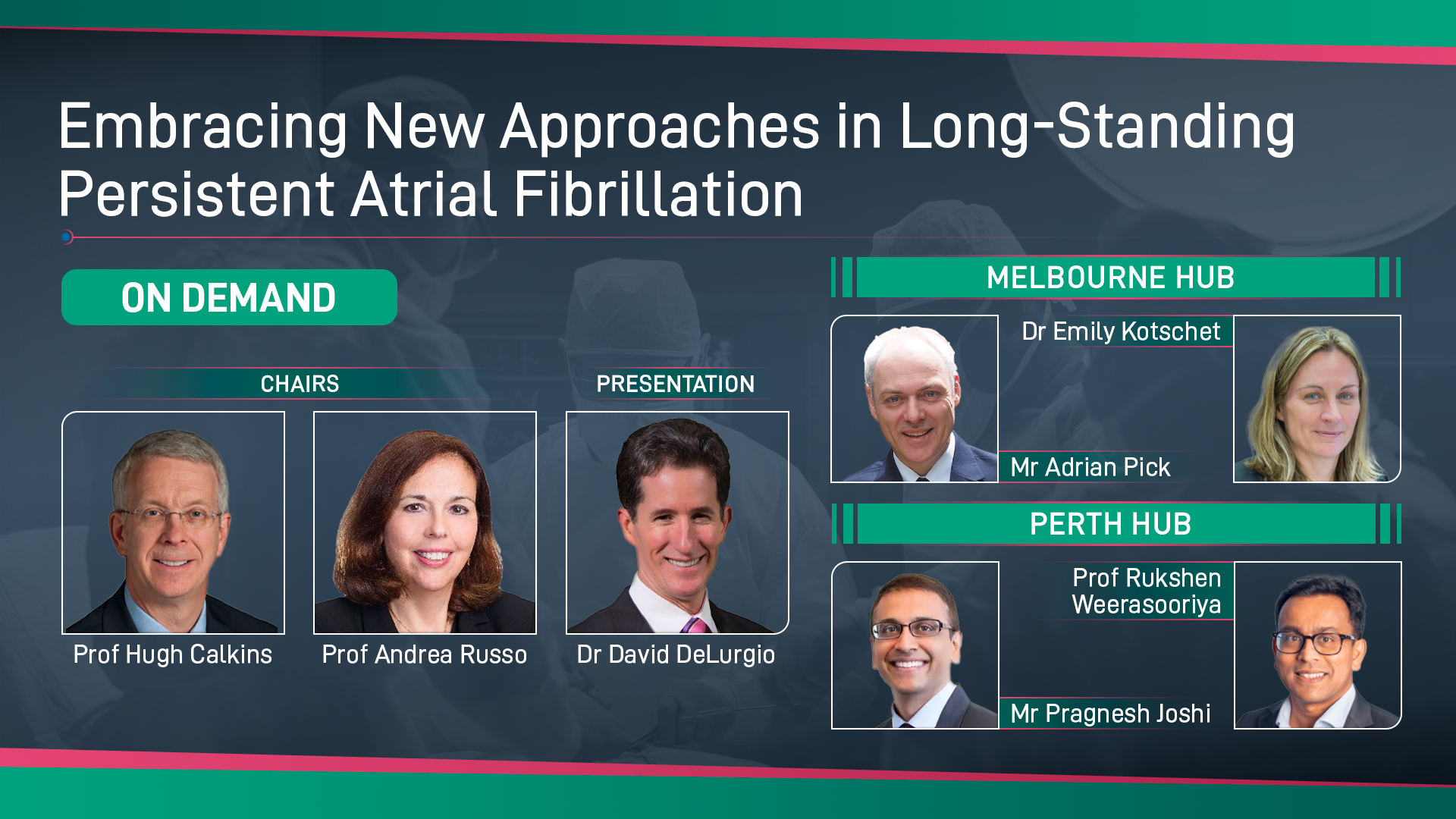Embracing New Approaches in Long-Standing Persistent Atrial Fibrillation
Published: 04 August 2022
-
Views:
 887
887
-
Likes:
 7
7
-
Views:
 887
887
-
Likes:
 7
7
-
 3m 59sPart 1 Welcome and Introductions Andrea Russo, Hugh Calkins, David DeLurgio, Rukshen Weerasooriya, Pragnesh Joshi, Emily Kotschet, Adrian Pick
3m 59sPart 1 Welcome and Introductions Andrea Russo, Hugh Calkins, David DeLurgio, Rukshen Weerasooriya, Pragnesh Joshi, Emily Kotschet, Adrian Pick
-
 12m 9sPart 2 Catheter, Surgical, and Hybrid AF Ablation: How Did We Get Here? Hugh Calkins
12m 9sPart 2 Catheter, Surgical, and Hybrid AF Ablation: How Did We Get Here? Hugh Calkins
-
 12m 34sPart 3 The Data Behind Hybrid Ablation David DeLurgio
12m 34sPart 3 The Data Behind Hybrid Ablation David DeLurgio
-
 12m 32sPart 4 Panel Discussion Andrea Russo, Hugh Calkins, Adrian Pick, Emily Kotschet, David DeLurgio, Rukshen Weerasooriya, Pragnesh Joshi
12m 32sPart 4 Panel Discussion Andrea Russo, Hugh Calkins, Adrian Pick, Emily Kotschet, David DeLurgio, Rukshen Weerasooriya, Pragnesh Joshi
-
 23m 53sPart 5 Adopting a Hybrid Approach Rukshen Weerasooriya, Pragnesh Joshi
23m 53sPart 5 Adopting a Hybrid Approach Rukshen Weerasooriya, Pragnesh Joshi
Overview
This on-demand version of the live broadcast aims to highlight the benefits of a hybrid management approach for minimally invasive procedures.
In non-paroxysmal atrial fibrillation (AF), where modification of the atrial arrhythmogenic substrate is required, catheter-based ablation using a transvenous, endocardial approach is commonly used but there is growing evidence for a hybrid approach to improve patient outcomes. Research suggests that an integrated approach involving both electrophysiologists and surgeons can lead to improved success rates and increased patient satisfaction compared with a catheter-only approach.
Whilst relatively new, hybrid AF ablation counts some of the world’s leading surgeons and electrophysiologists amongst its advocates. This expert-led broadcast is aimed at increasing awareness of the approach and helping physicians to adopt it in their daily practice, thanks to a series of practically-focussed presentations and discussions from some of the world’s leading experts.
Note, the live version of this session was CME accredited; this on-demand version is not.
Key Learning Objectives
- Define the key team members essential for the adoption of the convergent procedure
- Recall the scientific evidence supporting the safety and efficacy of hybrid ablation techniques in persistent AF
- Identify clinical and anatomical features that make patients good candidates for whom the convergent procedure
- Describe the role of electrophysiologist and surgeon in hybrid approaches
- Compare the overall approach to hybrid ablation with other approaches such as Mini Maze
- Identify local barriers preventing the uptake of hybrid ablation approaches
Target Audience
- Electrophysiologists (EPs)
- Cardiothoracic Surgeons
- Interventional and General Cardiologists
- Other referrers to EPs
More from this programme
Part 1
Welcome and Introductions
| 1 session | |
| Welcome and Introductions | Watch now |
Part 2
Catheter, Surgical, and Hybrid AF Ablation: How Did We Get Here?
Part 3
The Data Behind Hybrid Ablation
| 1 session | |
| The Data Behind Hybrid Ablation | Watch now |
Part 4
Panel Discussion
| 1 session | |
| Panel Discussion | Watch now |
Part 5
Adopting a Hybrid Approach
| 1 session | |
| Adopting a Hybrid Approach | Watch now |
Part 6
Minimally Invasive Approaches for Long-Standing Persistent Atrial Fibrillation: Building a Successful Practice
Part 7
The Future of Hybrid Surgical Ablation: Panel Discussion
Faculty Biographies

Emily Kotschet
Cardiologist and Electrophysiologist
Dr Emily Kotschet is a Cardiologist and Electrophysiologist with a particular interest in inherited cardiac arrhythmias, including cardiac genetics and atrial fibrillation (AF). She works at Holmesglen Private Hospital, Cabrini Hospital in Malvern, Mulgrave Private Hospital and St John of God, Berwick, where she implants devices and performs ablation for arrhythmias. She also provides cardiac services in rural Victoria visiting Alexandra and Morwell.
Dr Kotschet completed her cardiology training at the Alfred and Monash Heart, then completed a three year fellowship in Electrophysiology with 2 years in Canada. She returned to Monash Heart, and established the AF ablation program, including Australia’s first nurse led AF clinic, as well as the…

Adrian Pick
Cardiothoracic Surgeon
Mr Adrian Pick graduated in 1993, from the Melbourne University Medical School then completed overseas fellowships at the MAYO clinic and the Toronto General Hospital. His interests include minimal access surgery for thoracic and cardiac surgery with emphasis on mitral valve repair and limited access aortic valve replacement. He is also committed to maximizing surgical treatment for both concomitant (often in conjunction with mitral or aortic valve procedures) and lone atrial fibrillation.
More recently he has embraced the transition to Hybrid surgery. He favours the Totally thoracoscopic maze for patients with persistent Atrial fibrillation who have symptoms, have failed catheter ablation or are intolerant to antiarrhythmic drugs or anticoagulants.
…





